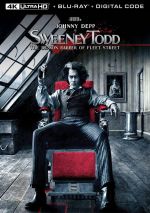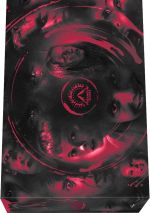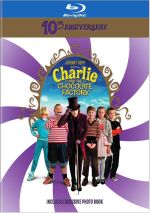|
PARAMOUNT
|


| |
|
MOVIE INFO
|
Director:
Tim Burton
Cast:
Johnny Depp, Helena Bonham Carter, Alan Rickman
Writing Credits:
John Logan
Synopsis:
Set in 1840s London, a barber returns from wrongful imprisonment bent on revenge for the rape and death of his wife.
Box Office:
Budget:
$50 million.
Opening Weekend:
$9,300,805 on 1249 Screens.
Domestic Gross:
$52,898,073.
MPAA:
Rated R.
| |
|
DISC DETAILS
|
Presentation:
Aspect Ratio: 1.85:1
Dolby Vision
Audio:
English Dolby TrueHD 5.1
English Audio Description
Subtitles:
English
Closed-captioned
Supplements Subtitles:
English
French
Spanish
Runtime: 116 min.
Price: $25.99
Release Date: 9/3/2024
Bonus:
• “Burton + Depp + Carter = Todd” Featurette
• “Sweeney Todd Press Conference”
• “Sweeney Is Alive!” Featurette
• “Musical Mayhem” Featurette
• “Sweeney’s London” Featurette
• “The Making of Sweeney Todd” Featurette
• “Grand Guignol” Featurette
• “Designs for a Demon Barber” Featurette
• “A Bloody Business” Featurette
• “Moviefone Unscripted” Featurette
• “The Razor’s Refrain”
• Photo Gallery
• Trailer
• Blu-ray Copy
| |
|
PURCHASE @ AMAZON.COM
|

| |
|
EQUIPMENT
|
-LG OLED65C6P 65-Inch 4K Ultra HD Smart OLED TV
-Marantz SR7010 9.2 Channel Full 4K Ultra HD AV Surround Receiver
-Sony UBP-X700 4K Ultra HD Dolby Vision Blu-ray Player
-Chane A2.4 Speakers
-SVS SB12-NSD 12" 400-watt Sealed Box Subwoofer
| |
|
RELATED REVIEWS
|

| |
|
Sweeney Todd: The Demon Barber of Fleet Street [4K UHD] (2007)
|
|
Reviewed by Colin Jacobson (October 24, 2023)
Tim Burton never seemed like the kind of director to take on a musical, but for his first foray into that genre, he found material that matched his tendencies: Steven Sondheim’s Sweeney Todd: The Demon Barber of Fleet Street. If ever a musical matched the macabre Burton’s style,
Todd would be that production. With its bloodshed and dark subject matter, it felt tailor-made for Burton, and Burton does make an interesting film with Todd, albeit not one that becomes wholly successful.
Set in 19th century London, barber Sweeney Todd (Johnny Depp) returns after 15 years at sea. Why did he depart? As we learn in flashbacks, Judge Turpin (Alan Rickman) lusts after Lucy (Laura Michelle Kelly), the wife of Todd – AKA Benjamin Barker, his real name.
The judge had Barker arrested on a trumped up charge, and eventually Lucy apparently commits suicide. The judge takes in Barker’s daughter Johanna and raises her.
His decade and a half in limbo traumatized Todd and left him a bitter man with no thoughts other than a desire for revenge, especially when he learns the fate of his wife and child. To that end, he sets up a new barbershop in a room above the meat pie establishment run by Mrs. Lovett (Helena Bonham Carter).
She makes terrible pies, but when Todd’s murderous streak emerges and he slits the throats of his customers, she decides to turn slaughter into commerce. She uses the corpses as her new ingredient, a choice that suddenly catapults her baked goods into sought-after delicacies.
The pair become close partners, though not as close as the romantically inclined Lovett desires. Todd remains completely focused on his plot for revenge, however, so her overtures go unnoticed.
In the meantime, a young acquaintance of Todd’s named Anthony (Jamie Campbell Bower) happens to spy a now-teenaged Johanna (Jayne Wisener) in her “cage” at the judge’s home.
He immediately becomes smitten with her and plans to find a way to free her. The film follows his endeavors but mostly concentrates on Todd’s quest.
For once in my reviewing career, I can examine a film adaptation of a stage production I actually saw. I wish I could provide excellent insights about the manner in which the two compare, but unfortunately, my memories of the live Todd remain thin.
As I watched the movie, I could recollect some of the show’s tunes and I maintained some vague images of the set but that was about it. Hey, I was only 12 at the time – whaddya want?
This means I’ll have to leave it to others to make more direct comparisons between the stage and film versions of Todd, though even my fading memories can come up with some changes. For instance, the show’s theme song goes missing here, and the film casts its leads in a younger manner, such as the fact Carter creates a much younger, sexier Mrs. Lovett than the original production’s Angela Lansbury.
Others will surely moan about the alterations, but I don’t think they create problems. Admittedly, my familiarity with the stage piece has eroded too much for me to say that with any certainty, but when I judge the movie take of Todd on its own merits, I think it succeeds.
With its bloodshed and dark subject matter, Todd certainly feels like the right material for Burton to enter into the musical genre. The director gives the flick a more graphic nature than many would preferred; those who expected a light musical experience left the theater shell-shocked from the massive quantities of spurting blood.
I won’t say that Burton plays those elements in a cartoony manner, but he doesn’t intend for the killings to come across in a truly horrific manner.
Instead, they play into the black comedic tone of the film. To be sure, Todd can become quite intense at times, but Burton usually prefers to throw in a dash of dark humor.
Those moments mesh with the violence and dour themes in a positive manner. The laughs never feel gratuitous or inappropriate, as they clearly match the feel of the flick.
The smooth manner in which Sondheim’s score and tunes fit into the film pleases and surprises me. The material doesn’t match my usual tastes, but these elements work well within the flick’s style.
Sondheim’s work proves relentlessly melodic, and the film integrates all the tunes in an unobtrusive manner. Songs come at us at a nearly incessant rate, but they don’t seem unnatural or overwhelming. The tale integrates them in a natural manner that assists the tale well.
I think many musicals suffer from too many songs because those sequences make the stories grind to a halt. How does Todd escape that fate?
In addition to Sondheim’s sheer talent, I also think it benefits from the lack of real production numbers. Most musicals throw out big dance numbers that can go on forever. While Todd features tons of tunes, there’s nary a jig to be found, a fact for which I’m eternally grateful.
Some critics knocked Todd for its actors’ relative lack of singing talent. No, Depp, Carter and the others don’t possess dynamic voices, but their acting skills make their vocal weaknesses essentially moot.
They invest potentially one-dimensional characters with enough life to overcome any minor distractions their singing might cause. I really think they carry the songs just fine.
Actually, a couple of actors do inspire my primary complaint about Todd: the scenes with Anthony and Johanna. Those sequences do surprisingly little to advance the story; they often feel more like plot devices than actual organic narrative elements.
The work by Bower and Wisener makes things worse, as those two provide dreadfully flat performances. In particular, Wisener kills the flick, as a mannequin could’ve played the part with greater personality. The Anthony/Johanna sequences tend to make the film grind to a halt.
Nonetheless, Todd succeeds much more than it falters. This isn’t a musical for everyone, as it’s far too violent and dark to appeal to a mass audience.
However, for those with a taste for this sort of material – and perhaps an aversion to the usual musical fluffiness - it’s a good experience.
|
The Disc Grades: Picture A/ Audio B+/ Bonus B+
|
|
Sweeney Todd: The Demon Barber of Fleet Street appears in an aspect ratio of approximately 1.85:1 on this 4K UHD Disc. A native 4K production, this Dolby Vision release came with a terrific presentation.
You won’t want to use it to show off your set’s color performance, though, as the vast majority of Todd went with essentially monochromatic material. The movie focused on a dull blue-gray most of the time, with inevitable bloody reds as well.
Some of Pirelli’s clothes showed greater vivacity, and flashbacks demonstrated a warm golden tint. The most extended segment with real colors came from Mrs. Lovett’s fantasy “By the Sea”, but it remained an exception to the rule.
When the more dynamic hues appeared, they looked fine, even if they stunned us due to their infrequency. During those scenes, I felt like I’d walked from a dark room into bright sunlight, as they really stood out as unusual in an otherwise relentlessly dark film.
In any case, the 4K reproduced the colors well. HDR gave the hues extra emphasis and punch.
Given the amount of gloomy, monochromatic elements, blacks became especially important. The transfer pulled off that side of things well, as the dark aspects of the image looked deep and firm.
Shadows were concise and clear at all times. I thought low-light sequences showed fine delineation and never appeared too thick or opaque. HDR also offered added power to whites and contrast.
Sharpness succeeded. The image presented appealing delineation, with virtually no softness along the way, not even during those many low-light shots.
No issues with jagged edges or moiré effects materialized, and I saw no edge haloes. Print flaws remained absent, and a fine layer of grain implied no intrusive noise reduction. The 4K UHD reproduced the source exceedingly well.
If you think the Dolby TrueHD 5.1 soundtrack of Sweeney Todd will focus mostly on music, then you win a prize, as songs and score heavily dominated the film’s soundfield. Those elements offered strong stereo delineation in the front channels and used the rears effectively to bolster the music.
Effects were more limited but perfectly acceptable. These tended toward general environmental bits, so don’t expect anything showy, but they added a little life to a mix that concentrated on music – as it should.
This meant the quality of the score and songs became particularly important. I’m happy to say the audio reproduction more than satisfied.
The music was robust and dynamic throughout the movie, and that side of things showed excellent reproduction. Speech was also warm and natural.
Effects demonstrated nice clarity and definition. I didn’t think the track packed enough oomph to enter “A” territory, but it worked well for this flick.
How did the 4K UHD compare to the 2008 Blu-ray version? Both brought identical Dolby YrueHD 5.1 audio.
As for the native 4K visuals, the Dolby Vision image offered superior accuracy, colors and blacks. The Blu-ray has held up pretty well over the last 15 years, but it couldn’t compete with this stellar 4K.
No extras appear on the 4K disc itself, but we get a bunch on the included Blu-ray copy. Burton + Depp + Carter = Todd runs 26 minutes, eight seconds as it brings comments from composer/lyricist Stephen Sondheim, director Tim Burton, producers Walter F. Parkes and Richard D. Zanuck, Johnny Depp’s vocal producer Bruce Witkin, music producer Mike Higham, and actors Helena Bonham Carter, Johnny Depp, Ed Sanders, Alan Rickman and Jamie Campbell Bower.
“Todd” looks at Burton’s interest in the musical and its adaptation for the screen, cast and performances, character makeup and design, and the film’s musical elements. The latter aspect of Todd dominates the program.
Next comes a November 2007 Sweeney Todd Press Conference that fills 19 minutes, 42 seconds. The panel includes Burton, Depp, Carter, Rickman, Zanuck, and actor Timothy Spall.
Like most press conferences, this one stays pretty light and focuses on general questions. It’s still entertaining, though, especially since it’s nice to see all the film’s principals together.
With that we head to eight featurettes. A look at the facts behind the fiction comes from the 20-minute, eight-second Sweeney Is Alive! The Real History of The Demon Barber.
It includes remarks from Burton, The Real Story of the Demon Barber of Fleet Street author Peter Haining, Open University (UK) Research Fellow in Literature Dr. Rosalind Crone, Oxford Dictionary of National Biography editor Dr. Lawrence Goldman, LSU Professor of English Sharon Aronofsky Weltman, “Penny Dreadful” expert Helen Smith, and crime historian Donald Rumbelow.
“Alive” seeks to investigate how much potential truth exists behind the Todd tale. It traces potential inspirations as well as the development of macabre literature in 19th century England and the iterations of the Todd story over the years. “Alive” gives us a good little take on the background behind the musical.
We get a look at the origins of the production via Musical Mayhem: Sondheim’s Sweeney Todd. This 12-minute, five-second show features Sondheim, Higham, Parkes, MacDonald, and screenwriter/producer John Logan.
“Mayhem” tells us about the development of the stage show as well as its adaptation for the screen. The best parts of “Mayhem” deal with the original Todd, and I wish we got more about it, especially in terms of how it differs from the movie. The rest of the piece is okay but it tends to become a bit fluffy after we shift to the film areas.
If you want to learn more about the story’s locations, go to Sweeney’s London. It fills 16 minutes, 17 seconds with notes from Rumbelow, Haining, Goldman, and Crone.
The program discusses the realities of London in the 18th and 19th centuries. It offers good background for more of the reality behind the Todd tale and entertains as it informs.
A better glimpse of the film production comes from the 24-minute, three-second The Making of Sweeney Todd. It gives us remarks from Burton, Sondheim, Depp, Spall, Carter, Zanuck, Bower, Rickman, MacDonald, Parkes, Logan, Witkin, Higham, makeup and hair designer Peter Owen, associate producer Derek Frey, costume designer Colleen Atwood, production designer Dante Ferretti, director of photography Dariusz Wolski, food stylist Katherine Tidy, special effects supervisor Joss Williams, property master David Balfour, and actors Jayne Wisener and Edward Sanders.
The show covers story and characters, cast and performances, translating the stage piece to the screen and Burton’s take on the material, various visual elements, aspects of the music, and general thoughts. A few good notes emerge, especially when we look at costume, production and prop design.
However, the main emphasis here is on promotion, so expect a lot of remarks about how wonderful everything is. This is a puffy program.
Grand Guignol: A Theatrical Tradition lasts 19 minutes, 16 seconds. In it we hear from Cardiff School of Creative and Cultural Industries Professors Richard J. Hand and Michael Wilson, The Grand Guignol: Theatre of Fear and Terror author Mel Gordon, “Le Theatre du Grand-Guignol” director Charles Nonon’s great-grandson Eric Horton, “Thrillpeddlers Hypnodrome” producer Russell Blackwood, and “Thrillpeddlers” co-founder/playwright Daniel Zilber.
We get an examination of the history of Grand Guignol theater and aspects of the genre. “Tradition” digs into the subject well and proves quite informative.
Some visual elements come up during the eight-minute, 56-second Designs for a Demon Barber. It provides notes from Atwood, Ferretti, Burton, and set decorator Francesca Lo Schiavo.
This one checks out set design, costumes, and some other visual elements. It throws out good details about that side of the production, especially when Atwood gives us a tour of the costumes.
Next comes the eight-minute, 53-second A Bloody Business with its statements from prosthetics creator Neal Scanlan. He goes the processes used to execute the throat-slitting scenes as well as a few other violent bits. Scanlan offers a nice tour and lets us learn the ins and outs of these gory sequences.
For more from the film’s two principals, we get Moviefone Unscripted With Tim Burton and Johnny Depp. During this 11-minute, 34-second piece, they take questions sent in by viewers.
Not a lot of meat emerges, but some interesting bits do crop up, such as when Depp tells us which of his characters he’d most want to meet in real-life. It’s entertaining.
Our final featurette lasts eight minutes, 40 seconds. The Razor’s Refrain actually offers a collection of stills accompanied by music from the film. Most of the images depict scenes from the flick, though a few behind the scenes shots appear as well.
It’s essentially a “Cliffs Notes” version of the story, as it follows events through images and songs. I’m not sure what point it serves, though if you only have a few minutes to watch Todd, this’ll do the trick.
In addition to the film’s trailer, we discover a Photo Gallery with 51 shots. Most of these cover the same territory viewed in “Refrain”, though we also get some promotional images and a few design sketches. It offers a nice little collection.
An unusually bloody and gloomy musical, Sweeney Todd: The Demon Barber of Fleet Street does not offer a cheerful night at the movies. The film adaptation of the production creates a dark and involving piece. As for the 4K, it boasts excellent picture and solid audio as well as a mostly useful and interesting compilation of supplements. Both the 4K and the movie satisfy and deserve my recommendation.
Note that this Sweeney Todd 4K can be purchased on its own or as part of a five-movie "Paramount Scares” box. That package also includes 4K UHD releases for Rosemary’s Baby, Pet Sematary (1989), Crawl (2019) and Smile (2022).
The "Scares" package also provides a special edition of Fangoria magazine along with some movie-related stickers.
To rate this film visit the original review of SWEENEY TODD
|
|



